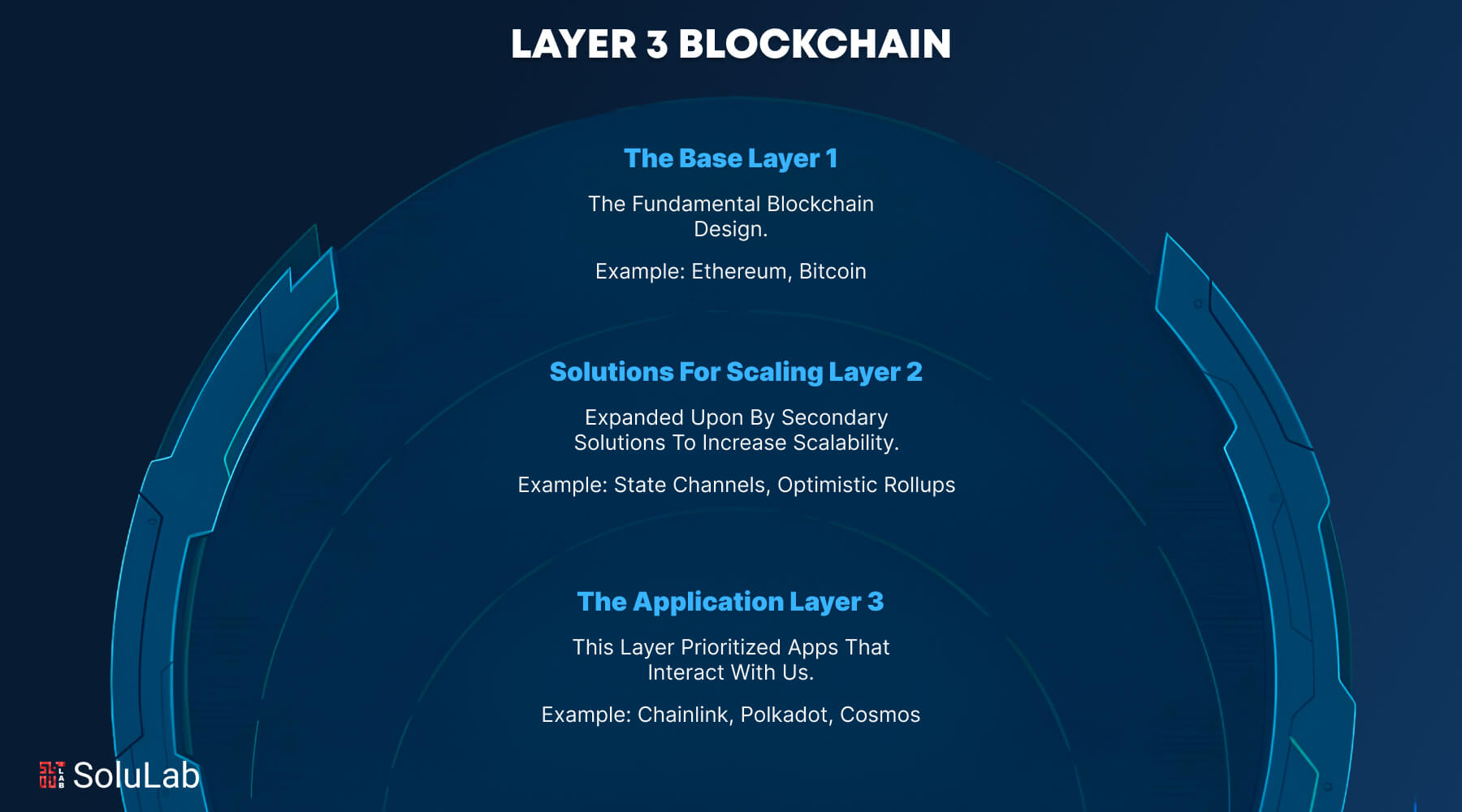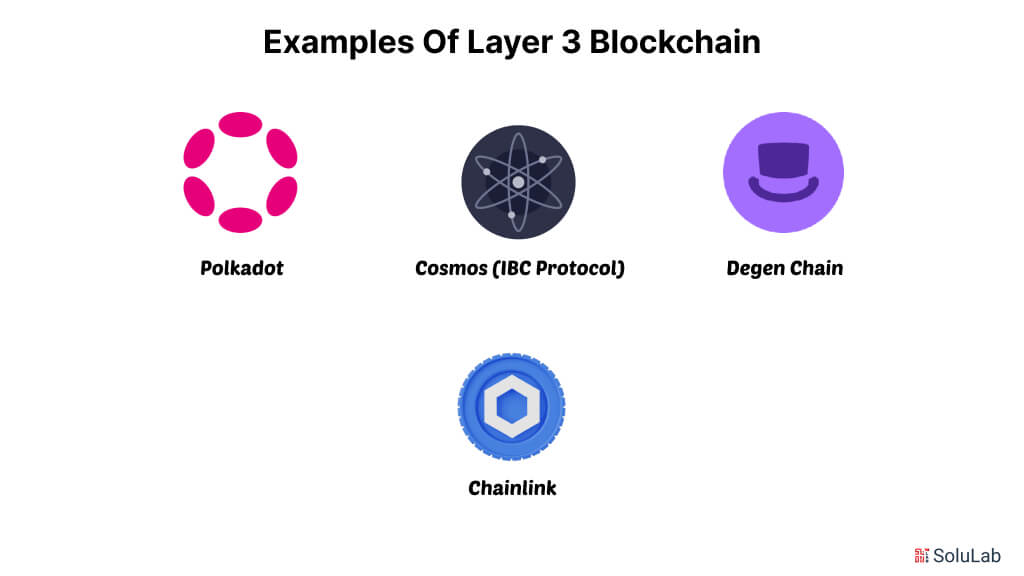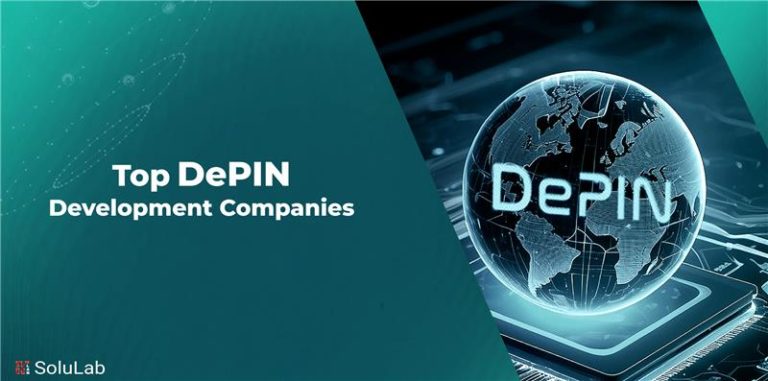
With the advent of blockchain platforms, there has risen another purely new type of software design. Layer 1s such as Ethereum or Bitcoin laid the starting point concerning security models, consensus methods, and procedures. The primary objectives of Layer 2 blockchains like state channels, Plasm, and optimistic rollups are to scale these base chains, increase the throughput, and lower fees.
Layer 3 brings about an additional aspect of decentralized applications: the ability to build highly specialized blockchains that might be appropriate best for a particular industry, or application, or with specific corporate needs in mind. Think of it as an approach of “you choose your adventure,” with regards to blockchain technology, allowing programmers to build blockchains that are tailored to the application of their choice.
This guide will keep you aware of What is Layer 3 in Blockchain, what services it offers, the benefits of using Layer 3 blockchain,n and how is it helping your business.
What Does Layer 3 Mean in Blockchain?
The layer called the application layer or Layer 3 facilitates between blockchain technology and client layers. Layer 1 is the original blockchain and layer 2 is a scaling solution, as its basis on top of which it is built. It is Layer 3 because it is intended to develop user-oriented programs and protocols that should allow the usage of blockchain ideas in everyday life, though Layer 1 Blockchains and Layer 2 exist to provide such things as scalability, security, and decentralization. This layer is particularly important to convey the value of blockchain technology to a general population because it interfaces with end users through usable interfaces and useful functionality.
The application of layer 3 blockchain has rapidly risen due to other developments such as smart contracts, and agreements that can be automatically executed without requiring third-party endorsement. There are more than 4,000 dApps currently in use on blockchains by 2023 across different industries such as gaming, healthcare, financiers, and supply chain. It is at layer 3 that this divide is bridged between utility, blockchain innovation, consumer-oriented solutions, and complex blockchain architecture.
Components of Layer 3 of Blockchain
How Layer 3 Blockchain work solve some of the challenges of end-users, who may use the blockchain to add practical applications so that adoption becomes a reality, the layer builds on the security and management of Layer 1 and Layer 2 blockchain solutions. The third layer is more focused on creating easy-to-use apps. Here are the essential components of Layer 3 Blockchain:
Decentralized Apps (dApps)
In blockchain architecture, dApps refer to software programs developed on the principles of transparent decentralized platforms. Some of these applications include and they make up the Layer 3 of the foundation of the blockchain. For instance, the trading of decentralized cryptocurrencies as captured by Dapps like PancakeSwap and Uniswap has revolutionized trading in the financial sector. The trading volume of these platforms in 2022 was above $2 trillion proving the growing popularity and popularity of these platforms.
Defi Platforms or Decentralized Finance Platforms
Layer 3 is incomplete without the decentralized financial markets known as Defi which comprises lending, borrowing, and interest-earning services. Through decentralized finance, majors like Aave and Compound remove factors like middlemen and allow users to make financial transactions directly with smart contracts. Defi platform has expanded exponentially; in 2023, the aggregated value for Defi was approximately $ 50 million, relatively close to $ 1 billion in the year 2019. This shows how adopted the industry has been and how it can change normal financial practices.
Blockchain-Based Services
Another blockchain service for which Layer 3 is implemented includes the blockchain gaming platforms and NFT marketplaces. This is particularly the case for new forms of trading, such as NFT on platforms like OpenSea as well as for the play-to-earn models based on gaming platforms like Axie Infinity. Grand View Research stated that the global NFT market only reached $20.44 billion in 2020, and could grow at approximately 33.9%, within the timeframe between 2023 and 2030.
Services of Layer 3 Blockchain
Layer 3 is the transition from complex blockchain and implementing integrated and easily navigable services. Services of Layer 3 Blockchain gives some solutions and tools that are useful for using blockchain technology in practical applications by users and enterprises.
Layer 3 provides industry-specific software solutions to firms in sectors including, but not limited to, gaming, healthcare, supply chain, and financial services section. For instance, through the removal of intermediaries in lending, borrowing,g or payment, the great decentralized finance platforms help companies to do the following. Smart contracts can also be employed for the management of procedures in businesses and this serves to reduce the operating cost and at the same time, reduce cases of errors. They also increase accountability and transparency, so companies can reduce instances of fraud and be sure that their products are genuine.
Layer 3 uses chain abstraction to give the customer applications for interaction with people and makes the upper level of blockchain technology applicable in the real world. Direct communication of people, non-hierarchical markets, and social networks that do not belong to one company use decentralized applications such as Binance or Ethereum smart chain. Furthermore, Layer 3 facilitates the trading of virtual commodities, collectibles, and digital art through NFT markets like OpenSea. With portals like Axie Infinity launching play-to-earn models, which allow players to make money by playing blockchain-based games, the gaming sector has also exploded.
Additionally, key Features of Layer 3 Blockchain are data management services and identity, providing consumers more authority over their personal information while maintaining security and privacy via decentralized frameworks. These technologies help firms increase consumer compliance and trust. Layer 3 blockchain, converts the technological promise of blockchain into practical uses, promoting a decentralized, user-focused digital economy that benefits both individuals and enterprises.
Examples of Layer 3 Blockchain

Here are some significant Layer 3 Blockchains including their primary functions and benefits:
-
Polkadot
Polka Dot’s multi-chain architecture, which includes a relay chain and para chains, promotes interoperability and scalability. Its layer 3 design facilitates cross-chain communication and transfer of assets which results in a more efficient dApp functionality. The network’s governance and security are driven by its native token DOT. Parallel Finance, Moonbeam, and Acala are among the most well-known Polkadot chains.
-
Cosmos (IBC Protocol)
Cosmos Inter-blockchain communication (IBC) protocol facilitates smooth connectivity between related blockchains. IBC facilitates the secure movement of currencies and data between networks, allowing decentralized applications (dApps) to use a variety of blockchain features. This supports the cosmos concept of the “Internet of Blockchains”. Injective, Osmosis, and Axcelar Network are the key initiatives that use IBC.
-
Degen Chain
Dege chain, which is built on the base blockchain, focuses on quick gaming and payment transactions. Its layer 3 architecture offers affordable, rapid connectivity processing, making it appropriate for certain applications. With quick adoption, including a $100 million transaction volume immediately after the launch, it supports developing an ecosystem of tokens such as Degen Pepe (DPEPE) and Degen Swap (DSWAP)
-
Chainlink
Chainlink which is often known as a decentralized oracle network, demonstrates Layer 3 characteristics by connecting smart contracts to real-world data. It improves dApps for Defi, insurance, and gaming by supplying safe, tamper-proof external data. Blockchain networks like Plygon, Ethereum, and Avalanche use Chainlink to enhance their capabilities. Link, the native token promotes security and reliability on the network.
How is Layer 3 Different From Layer 1 and 2?
| Features | The Base Layer 1 | Solutions for Scaling Layer 2 | The Application Layer 3 |
| Meaning | The fundamental blockchain design. | Expanded upon by secondary solutions to increase scalability. | This layer prioritized apps that interact with us. |
| Goals | Offers transaction validity, security, and decentralization. | Increases layer 1 blockchain’s efficiency and scalability. | Provide users with user-friendly protocols and apps. |
| Cost of Transactions | Usually greater due to the network congestion | Decreased expenses with the removal of transactions off the main chain. | The support layers 1 and 2 determine the cost efficiency of layer 3. |
| Speed of Transactions | Restricted eg Ethereum 30 TPS, Bitcoin 7 TPS. | Significantly greater as a result of off-chain transaction processing. | With an emphasis on smooth user contracts, speed varies depending on the application. |
| Use Case Focus | Building a decentralized and safe infrastructure. | Increasing efficiency and scalability for wider blockchain applications. | Practical use cases such as blockchain gaming, NFT trading, and DeFi. |
| Key Features | Systems for consensus, security, and decentralization. | Faster transactions, scalability, and lower expenses. | dApps, blockchain interoperability, and smart contracts. |
Real-World Use Cases of Layer 3 Blockchain

Several use cases of Layer 3 Blockchain, if you hire blockchain developers, illustrate their adaptability and possible influence on the blockchain sector:
1. Gaming
Layer 3 blockchains are capable of grounding highly complicated but necessary gaming structures and interactions, which require seamless and fast functionality. Xai Network is an optimized gaming blockchain designed on Arbitrum Layer 2 solution with Layer 3 solutions in mind. Its objective is to offer the developers elements that make the creation of games with lots of active players and fights possible.
2. Finance
For the leading blockchain consulting companies, Layer 3 solutions in decentralized finance reduce transaction time and provide more efficient processing of financial goods. At the moment, dYdX Immutable X, and all other DeFi rely on StarkWare’s Layer 3 scaling solutions to enhance transaction velocities and to make DeFi as fast and available as it is.
3. Supply Chain Management
Supply chain processes’ reliability increases when confirming operations with Layer 3 Blockchain architecture, through which the effectiveness of the respective raises. For instance, VeChain utilizes Layer 3 solutions for the provision of integrated supply chain solutions. Thanks to their technology, their items may be traced from the point of origin down to the end consumer.
4. Healthcare
These systems can with relative ease and more confidentiality handle health-sensitive data, which will in turn enhance information confidentiality and at the same time enhance the rate at which information can be accessed. For instance, it uses Layer 3 blockchain to share and protect health record data in MediBloc shares. For patients and other healthcare professionals, it has increased value as a result of the availability of data and security.
5. Social Media
Thus, Layer 3 technologies being free from the limitations of traditional networks, may serve as the basis for autonomous social networking applications that ensure secure communication. Minds is a decentralized social media that provides its users with a private, freedom-of-speech environment and operates on a Layer 3 blockchain solution.
Advantages of Layer 3 Blockchain
The application layer or Layer 3 blockchain is essential for many advantages to provide users with and here are the following advantages of Layer 3 Blockchain that you can know more about with a blockchain consulting company:
Improved User Experience
Improving the accessibility of blockchain technology is another goal of Layer 3 Emerging Technologies Inc., As one of the easier types of blockchain apps for the average user, decentralized finance (DeFi) and decentralized apps (dApps) have interfaces that obscure the underlying fundamentals of blockchain technology. Some examples include Uniswap and Aave in particular: these platforms ensure people receive well-functioning monetary value exchange and can interact with blockchains even when they have no programming experience.
Diverse Application Development
DADL 3 allows the development of different types of applications utilizing blockchain technology, including art and gaming, and the financial industry. Though blockchain games like Axie Infinity have structures that empower players economically through play to earn models, programs like NFT markets such as OpenSea empower artists through sales of their art. This is because blockchain technology can interconnect with several sectors in different industries such as supply chain, healthcare, and entertainment business.
1. Scalability Through Integration of Layer 2
Layer 3 leverages Layer 2 scaling solutions to give integrated experiences and Layer 1 blockchains like, Ethereum and Bitcoin face a problem of transaction charges and speed. Layer 3 applications can scale higher transaction rates and lower fares through integration with Layer 2 solutions including the Lightning Network or Optimism Rollups.
2. Interoperability Between Blockchains
This can then be narrowed down to the interoperation between different blockchains. Layer 3 brings in Interoperability defi protocol, which is defined as the means that allows multiple blockchains to interact. This feature enables applications to access several networks all of which enhance usage as well as options for the users. For instance, one DeFi application developed on Ethereum can swiftly interact with data or services of Binance Smart Chain. Interoperability breaks limitations, eliminates siloes, and helps the blockchain industry to develop into a unified network.
3. Additional Security and Confidentiality for Users
Layer 3 apps provide functions like being able to have our documents stored securely and have true self-ownership of identity but built on Layer 1 security chains. This will put users in a much better position to control the personal data in question. These Layer 3 apps offer smart contract integration with automated as well as tamper-proof agreement execution which enhances reliability and certainty.
4. Business Management Cost-Effective Measures
Layer 3 blockchain allows businesses to integrate blockchain technology into their operations at a lesser amount of money. Applicants may delete costs and middlemen through decentralized structures and smart contract solutions that use procedures. It is particularly beneficial for industries of supply chain management where the imperative understanding of efficiency and transparency is critical.
5. Promoting the Use of Bitcoin
Layer 3 is the reason why blockchain technology is so well adopted today. Layer 3 eliminates the technological issues associated with prior layers by incorporating practical use cases that solve practical problem areas. Layer 3 gives blockchain a global adoption front door across decentralized finance systems that provide financial access and capacities, and blockchain gaming that creates new economic opportunities.
Why Does Your Business Need Layer 3 Blockchain?
The third layer provides specific solutions for enterprises and possesses the Layer 2 technologies’ scalability factors. Layer 3 makes for easy processing without a pile of network traffic or costly charges per transaction in sectors that experience large transaction turnover such as the tail or financial services sector. It can also ensure that the establishment of your technology infrastructure will hold capacity to accommodate the growth of your company. Layer 3 blockchain allows you to meet the fast, secure, and transparent services demanded by today’s consumers. Contrary to that, Layer 3 blockchain empowers firms to offer unique and accessible digital interactions such as NFT commercialization through the marketplace or DeFi transactions via P2P financing.
In contrast to Layer 1 and Layer 2, which concentrate on infrastructure Layer 3 incorporates blockchain capabilities straight into regular business processes. For instance, a logistics company can employ blockchain-based supply chain tracking to improve operational transparency and efficiency. By facilitating decentralized ecosystems, Layer 3 blockchain opens up new revenue streams. For instance, NFT markets enable companies to make money from digital collectibles, while blockchain-based games allow gaming companies to profit from the play-to-earn economy.
The worldwide transition towards decentralization is unavoidable and organizations using Layer 3 blockchain beforehand will gain a competitive advantage. Implementing Layer 3 solutions puts your company at the vanguard of innovation, prepared for adaptation to decentralized systems for settlements, verification of identity, and management of digital assets. Layer 3 supports long-term business objectives by turning blockchain technology realistic, scalable, and customer-focused. Layer 3 provides the capabilities that are in a way quite necessary for improving performance efficiency, offering major services, and expanding into new markets.
How Can SoluLab Help Your Business With Blockchain Solutions?
Layer 3 blockchain is the next step in the growth of decentralized technology, with an emphasis on practical uses that meet the demands of businesses and consumers alike. By building on Layer 2’s scalability and Layer 1’s security, Layer 3 blockchain allows sectors to capitalize on blockchain’s disruptive potential without sacrificing scalability, cost-effectiveness, and efficiency. Layer 3 blockchain helps businesses prosper in an increasingly digital world by allowing frictionless transactions, boosting supply chain transparency, and unleashing fresh revenue streams with the help of decentralized systems. Adopting layer 3 is much simpler than keeping competitive today, it is about preparing your firm for a more decentralized future.
We at Blockchain development company, SoluLab pride ourselves on helping organizations fully harness Layer 3 blockchain technology through our great Blockchain as a Service (BaaS) solutions. Having gained vast experience in the design and implementation of complex blockchain applications in the enterprise, we assist in achieving corporate objectives as with OBORTECH’s Smart Hub. This innovative system does not only include the powerful BaaS functionalities, but also the IoT system fully integrated with the BaaS platform; It offers unsurpassed clarity, accountability, and real-time data control and communication. It makes it easy for firms in different sectors of the economy to implement, develop as well as sustain blockchain solutions due to a team of professionals backing us. Here is your reliable blockchain innovation partner, a friendly interface, powerful analytical features, and compatibility with AWS, GCP, and Azure.
Are you ready to change the way you operate with blockchain? Contact SoluLab today and get customized solutions according to your business and needs.
FAQs
1. What exactly is Layer 3?
Layer 3’s primary function includes routing and forwarding, other than that it also works on addressing, congestion control, error handling, and packet sequencing including certain protocols.
2. Solana comes under which layer?
Solana is the premier smart contract blockchain that prioritizes high efficiency and low transaction costs. Solana is a Layer 1 blockchain and is also a part of the smart contract platforms.
3. What are the five layers of blockchain?
Blockchain is primarily made of five layers which are hardware infrastructure, data, network, consensus, and application. Each of these layers comprises a distinct functionality of its own.
4. How is Layer 2 different from Layer 1?
Layer 2 happens to be an overlay network that sits on top of Layer 1 and improves scalability and functionalities. Layer 3 runs real-world apps and performs tasks.
5. Can SoluLab help your business by incorporating Layer 3 for your operations?
SoluLab can incorporate Layer 3 blockchain and improve interoperability, scalability, and flexibility for enterprises. These abstractions streamline application-specific capabilities, allowing for seamless integration.






